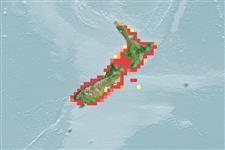Pycnogonida |
Pantopoda |
Rhynchothoracidae
Environment: milieu / climate zone / εύρος βάθους / distribution range
Οικολογία
; εύρος βάθους 51 - 101 m (Αναφ. 9). Temperate; 34°S - 47°S, 166°E - 179°E
Southwest Pacific: New Zealand.
Length at first maturity / Μέγεθος / Weight / Age
Γεννητική Ωρίμανση: Lm ? range ? - ? cm
This tiny species has a papillose integument an is otherwise quite tuberculate. There are three robust dorsomedian tubercles only slightly taller than their diameters. The lateral processes have low dorsodistal tubercles broader than tall and gradually decreasing in seize posteriorly. The ocular tubercles low, fairly broad, and has an anterior extension projecting about 0.3 of the proboscis length. The eyes are indistinct with very little pigment. The proboscis is typical. The abdomen is fairly long, extending to the distal rim of second coxae on the fourth leg pair. The palps are robust, 4 segmented, slightly longer than the proboscis, and the first or longest segment bears a dorsodistal tubercle slightly longer than its dorsal tubercle just proximal to the distal tip. Distal two segments no longer than their diameters, terminal segment only a tiny knob. The ovigers are typical, with curved terminal claw. Legs are robust, short, first coxae with low rounded tubercle each. Propodus well curved, main claw robust, with short auxiliary claws (Ref. 9).
Depth based on occurrence record; to be replaced with better reference.
Life cycle and mating behavior
Γεννητική Ωρίμανση | Αναπαραγωγή | Γεννοβολία | Eggs | Γονιμότητα | Larvae
Members of the class Pycnogonida are gonochoric and sexually dimorphic. During copulation, male usually suspends itself beneath the female. Fertilization occurs as the eggs leave the female's ovigers. Males brood the egg masses until they hatch. Life cycle: Eggs hatch into protonymphon larva then to adults.
Child, C.A. 1998 The marine fauna of New Zealand: Pycnogonida (sea spiders). NIWA Biodiversity Memoire 109. National Institute of Water and Atmospheric Research (NIWA). Washington, D.C. 20530, USA. 71 p. + Figure 2A-G, 3A-F, 4, 5. (Αναφ. 9)
IUCN Red List Status
(Αναφ. 130435: Version 2025-1)
CITES status (Αναφ. 108899)
Not Evaluated
Not Evaluated
Threat to humans
Human uses
| FishSource |
Εργαλεία
Περισσότερες πληροφορίες
Τροφική ΟικολογίαFood items (preys)
Σύσταση δίαιτας
Κατανάλωση τροφής
Θηρευτές
Population dynamicsΑύξηση
Max. ages / sizes
Length-weight rel.
Length-length rel.
Length-frequencies
Mass conversion
Αφθονία
Life cycleΑναπαραγωγήΓεννητική ΩρίμανσηΓονιμότηταΓεννοβολίαEggsEgg developmentLarvae PhysiologyΚατανάλωση οξυγόνου
Human RelatedStamps, coins, misc.
Διαδικτυακές πηγές
Estimates based on models
Preferred temperature
(Ref.
115969): 9.9 - 17, mean 14.8 (based on 15 cells).
Price category
Unknown.
